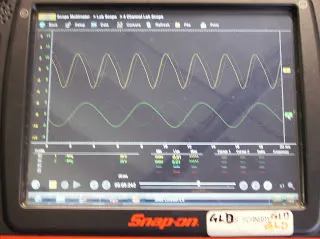This vehicle came into our shop with a laundry list of codes, no power, and it couldn't shift. I scanned for codes and found P0715, 717, 718, 731, 732, 733, 734, 745, and P2106. As you can see it, had turbine speed sensor codes, gear ratio codes, pressure control fault and a forced limited power from the TAC.
My first thought was that the turbine speed sensor had failed, causing the other codes. I looked at the data on the scan tool. There was a signal from the turbine speed sensor but it was very erratic. I recommended we do further testing on the system to pinpoint the fault but the vehicle owner wanted to replace the turbine sensor. Reluctantly, we did, but the problem was still present. The vehicle owner didn't want to go any further at this time.
A month later our customer brought their Lincoln LS back and said it was still acting up and wanted the advanced diagnostics performed. I scanned the computer again and found the same codes plus a new one: P1397 (system voltage out of range). When I raised the hood to check the engine oil level, I found the TAC assembly had been replaced. I asked who replaced it and was told there was a code for it so the owner of the vehicle bought one and put it on. I wasn't surprised, as that's the same mentality they had the first time we looked at the vehicle.
First things first I did was a battery and charging system analysis. This should be the first step in any analysis, but especially with the system voltage out of range code. Everything but the battery tested OK, so we replaced it with a new one.
Now that we had the go ahead to dig deeper, we had a fighting chance to figure this out. I printed off a wiring schematic and studied it briefly. The transmission uses three speed sensors: turbine speed, intermediate shaft speed, and output shaft speed. The code reference is for the turbine speed sensor and says nothing about the intermediate shaft speed sensor until you get into the pinpoint test. The pinpoint test then instructs on how to test each of the three components. Now I'm thinking since there's no specific code for the intermediate shaft speed sensor, could this be our culprit, as it shares the turbine sensor code? I accessed the wire harness at the power train control module and probed the turbine speed sensor wires and the intermediate shaft speed sensor wires at the PCM. We ran the car through the gears.

There is no data PID for the intermediate shaft on my scan tool.

The turbine sensor (green trace) had a good wave pattern and the intermediate shaft had a flat line (yellow trace).

At the same time the graphing scan data showed an erratic turbine speed sensor. I wondered if a failed intermediate shaft sensor could be causing an erratic reading on the scanner. I would need to replace the intermediate shaft sensor to find out. We replaced it, and with all the probes still connected I started the engine and watched the pattern. The intermediate shaft was now working.

The yellow trace is the turbine speed sensor and the green trace is the intermediate shaft sensor. Both had good patterns. Next, I checked the scan tool to see if the turbine sensor reading had cleaned up.

It hadn't. I played around with the engine RPM to see what would happen. If I kept it below 1230rpm the reading on the scan tool was a clean line. Once it went over that threshold, the reading became erratic. We were getting a good signal to the computer, but a bad signal on the scan tool. We recommended a replacement PCM, but the customer declined the repairs because they had no more money to put into the vehicle. So at this point, the vehicle still has an issue.
I'm thinking to myself had the owner not been so hasty to replace the TAC assembly and allowed us to diagnose the problem initially, there may had been enough money in the kitty to repair the vehicle.
Maybe we'll see it back in a month.
 Certified Transmission
Certified Transmission
